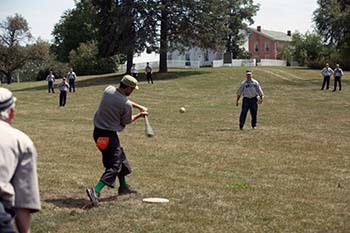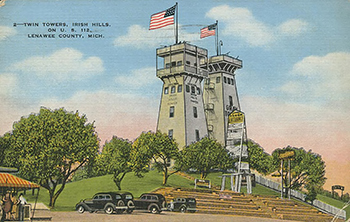Revisiting the historic Walker Tavern and tourism in the 1920s Irish Hills
Editor’s note: In celebration of the department’s centennial anniversary, the Showcasing the DNR feature series will highlight one story each month during 2021 that recalls various accomplishments of the department over the past century.
By LAURIE CATHERINE PERKINS
Michigan Department of Natural Resources
By the time the Michigan Department of Conservation – the Department of Natural Resources’ predecessor – formed in late March 1921, the Walker Tavern, located southeast of Jackson at the corner of U.S. Highway 12 and M-50 near Brooklyn, was nearing its 100th birthday.
Built in 1832, the tavern served as a wayside inn, bar and post office for travelers on the “Old Chicago Road.” In the 1920s, the tavern would find new life as a roadside tourist attraction, and in 1965 it became a Michigan state park.
Today, the tavern is part of Cambridge Junction Historic State Park in Lenawee County, which the DNR manages.
A century ago, life was changing for many Americans. Shorter work weeks, higher wages and Henry Ford’s new, affordable Model T paved the way for a new industry: automotive tourism.

Thousands of Michigan residents escaped city life, if only for a day, to visit more pastoral settings. Southeast Michigan’s “Irish Hills,” about 75 miles southwest of Detroit, became a popular destination.
In 1920, the Walker Tavern was owned by W. C. Dewey and facing an uncertain future. Franklin Dewey, the owner’s cousin, wrote that the old tavern, in the right hands, could be “one of the most valuable monuments or museums in the state. ... The edifice is one of the most venerable in Michigan and is surpassed by few, if any, in historic associations.”
Franklin’s father, Francis A. Dewey, had been the tavern’s third owner. He had meticulously documented its history. Unable to turn it into a successful business, the family was ready to sell the property, with the hope it would continue to be cherished and preserved.
Episcopalian priest Frederick Hewitt was familiar with the Irish Hills, having served the local community at churches in Clinton and Tecumseh. A longtime friend of Henry Ford, Hewitt shared Ford’s interest in antiques. He purchased the historic tavern in November 1921 as a place to show and sell his collectables.
Hewitt opened the tavern as a museum on May 30, 1922. He grew his new business into one of the most famous tourist attractions in the Irish Hills. Going on buying trips with Henry Ford, Hewitt supplied the tavern with antiques and created a museum, gift shop and, later, a restaurant.
|

Spurred on by his early success, Hewitt purchased the Brick Walker Tavern just across the road in November of 1922. With the Brick Tavern ready to open the following year, Hewitt began to plan huge public events to bring in nationwide business. Among his first guests were a couple from Alabama.
In addition to Henry Ford and his wife Clara, Hewitt drew on his connections with college presidents, governors and other highly placed civic leaders to raise the profile of his new enterprise.
Irish Hills tourism in the 1920s
The scenic beauty of gently rolling hills and clear blue lakes around the Walker Tavern did not go unnoticed by others seeking to make the Irish Hills a tourist destination.
The newly created Michigan Department of Conservation purchased acreage on the south shore of Wamplers Lake. In 1921, it became Cedar Hill State Park, which is known today as Walter J. Hayes State Park.
The Department of Conservation wasn’t alone in seeing the opportunity for tourism in the area. The locally based Michigan Observation Company built a 65-foot-tall viewing platform on a knoll halfway between Hewitt’s Walker Tavern and Cedar Hill State Park. It opened to the public in October 1924.
Adjoining property owner and local farmer Edward Kelly, angered by the location of the first tower, immediately built a second tower. A “race to the top” ensued. Soon each of the “Twin Towers” had its own restaurant, gift shop, hotel and gas station along then-U.S. Highway 112.
|

Frederick Hewitt and his family owned and operated both historic buildings at the junction well into the mid-20th century, selling chicken dinners, postcards and antiques.
The post-World War II economy and subsequent baby boom revitalized tourism in the Irish Hills. New theme and amusement parks, based on popular television shows, were added to the mix of 1920s-era attractions. The Irish Hills was alive with tourists for a second generation.
Walker Tavern becomes a state park
In the mid-1900s, the DNR was looking to expand its statewide park system, and again turned to the Irish Hills as a possible location. Frederick Hewitt’s daughter, Jeanne Keith, encouraged the department to look at the Walker Tavern and its 80 acres as a possible historic park.
In 1965, the Walker Tavern became part of Cambridge Junction Historic State Park, named for the community that once thrived at the intersection of old Chicago Road (U.S. Highway 12) and the La Plaisance Bay Pike (M-50). The park, known locally as the Walker Tavern Historic Site, continues to be an asset to tourism in the Irish Hills under the DNR’s care.
“For 100 years, historic Walker Tavern has transported – through imagination and interactive experiences – thousands of visitors back to the settlement days of Michigan and Lenawee County,” said local historian Dan Cherry. “The tavern, at the crossroads, continues to captivate and educate us about all the people who came before us and how they lived."
|

Walker Tavern Today
The Walker Tavern Historic Site, which includes the tavern, a historic barn and a visitor center in the adjoining Hewitt home, is managed by the DNR’s Michigan History Center.
Since 2008, the site has been supported by a very active and engaged friends of the park group. In addition to supporting the site’s many educational activities, the friends organize a farmers market within the state park. Thousands of visitors come each summer for fresh produce and homemade crafts.
Due to the ongoing coronavirus pandemic, the farmers market is temporarily moving to Onsted for 2021, which makes it easier and safer to access the market. The market is scheduled to return to the park in 2022.
“We enjoy being a part of the history, beauty and nature that comes with being a part of the historic site,” said local resident and market master David Brainerd.
Brainerd’s wife, Marcy, described the market’s customers by saying, “We have become a family and enjoy being a part of this community.”
Others praise the efforts to preserve the history of the location.
“In all the years that I’ve been associated with the Walker Tavern Historic Site, I have seen it grow from just a small park on the corner into a thriving destination with a farmers market and programs for the public,” said Laurie Bolak, a member of the Friends of Walker Tavern for many years. “I feel strongly that the history depicted at the site is so very important to preserve.”
Laurie’s husband, Frank, president of the Friends of Walker Tavern, agreed.
“Walker Tavern Historic Site is one of the great jewels of the Irish Hills,” he said.
Thanks to a decade of support from Michigan’s Recreation Passport program, major restoration projects at the Walker Tavern Historic Site have been completed. In 2019, the windows were removed and completely restored. In 2020, staff completed new interior renovations, including a large hand-stenciling painting project. This summer, the tavern’s exterior will be repainted.
If you have never been to the Irish Hills, or perhaps not for many years, or if you were there only last week, take a trip, enjoy some of Michigan’s natural and cultural resources and be a part of the next hundred years of the Walker Tavern’s history.
The Friends of Walker Tavern invite you to become a friend and to follow the site’s many events and activities at Michigan.gov/WalkerTavern.
|
Check out previous Showcasing the DNR stories in our archive at Michigan.gov/DNRStories. To subscribe to upcoming Showcasing articles, sign up for free email delivery at Michigan.gov/DNR.
/Note to editors: Contact: John Pepin, Showcasing the DNR series editor, 906-226-1352. Accompanying photos and a text-only version of this story are available below for download. Caption information follows. Credit Michigan Department of Natural Resources, unless otherwise noted.
Text-only Showcasing Story - Walker Tavern
Base Ball: The Walker Tavern Wheels vintage base ball team hosts games and invitationals each summer on the grounds behind the tavern. The 2021 game season is still being determined. Check the website, Michigan.gov/CambridgeJunctionHSP, later this spring for more information.
Hayes: Michigan’s Irish Hills became a popular tourist area in the early automobile area. The Michigan Department of Conservation, the precursor to the Michigan Department of Natural Resources, developed Cedar Hill State Park in 1921. Credit: Archives of Michigan.
Marker: Forrest Keith, Frederick Hewitt’s son-in-law, stands next to the Michigan historical marker that was installed in 1957. A new historical marker for the tavern was installed by the Friends of Walker Tavern in 2007. Credit: Archives of Michigan.
Market: For more than a decade, the Walker Tavern Farmers Market has taken place on the park’s grounds Sunday mornings from May to October. Due to the COVID-19 pandemic, the market did not run in 2020. Plans for the 2021 market are still under development.
Postcard: This 1940s postcard shows the Walker Tavern during the Hewitt family heyday. Credit: Archives of Michigan.
Stencil: In 2020, as part of interior renovations, Michigan History Center staffers created custom stencils, which they used to hand-paint designs onto the repaired plaster walls.
Tavern: Today, the Walker Tavern sits several feet above U.S. Highway 12, just west of M-50. The porch was removed when the road was regraded and widened in the 1960s. The exterior will be repainted later this spring.
Towers: One of the most popular early tourist attractions in the Irish Hills was the Twin Towers. Credit: Archives of Michigan./
|